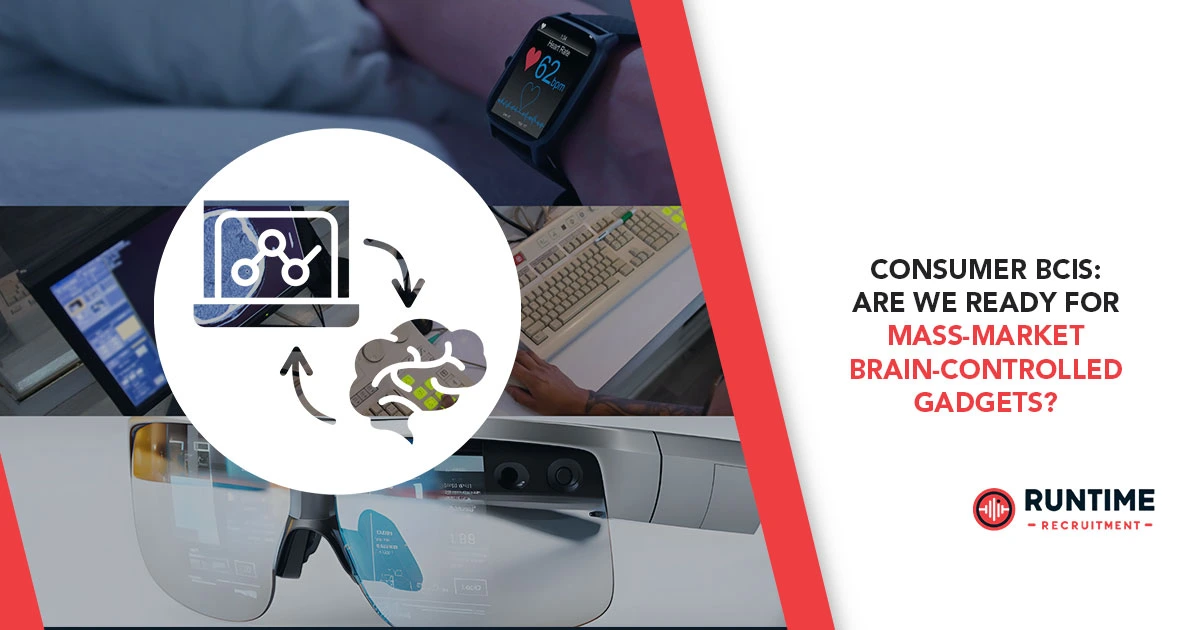The dream of controlling technology with our minds has captivated humanity for centuries. From science fiction novels depicting telekinetic heroes to futuristic movies showcasing neural interfaces, the allure of direct brain-computer interaction (BCI) is undeniable. For embedded engineers, this isn’t just a fantasy; it’s a rapidly evolving field presenting both immense opportunities and daunting challenges. As we stand on the cusp of mass-market consumer BCIs, the critical question arises: are we truly ready?
The BCI Landscape: From Lab to Living Room
For decades, BCIs have primarily been confined to research laboratories and specialized medical applications. Think of neuroprosthetics allowing paralyzed individuals to control robotic limbs or sophisticated systems aiding communication for those with locked-in syndrome. These medical-grade BCIs are often invasive, requiring surgical implantation, and are meticulously calibrated for individual users.
However, the past decade has witnessed an explosion of non-invasive BCI technologies. These devices, worn externally like headbands or headphones, measure brain activity through electroencephalography (EEG). Companies like Emotiv, NeuroSky, and Muse have pioneered consumer-grade EEG headsets, initially targeting applications like meditation, cognitive training, and rudimentary game control. While these early devices offered a glimpse into the potential of brain-controlled gadgets, their limited functionality, often inconsistent performance, and steep learning curves prevented widespread adoption.
Today, the landscape is far more sophisticated. Advances in signal processing, machine learning, and miniaturization have led to BCIs that are more accurate, comfortable, and user-friendly. We’re seeing prototypes and early commercial products promising everything from controlling smart home devices with a thought to enhancing gaming experiences, and even influencing creativity and focus.
The transition from specialized medical tools to mass-market consumer products is a monumental leap. It necessitates a fundamental shift in design philosophy, cost structures, user experience, and, crucially, the underlying embedded systems.
The Embedded Engineer’s Crucible: Challenges and Opportunities
For embedded engineers, the rise of consumer BCIs represents a new frontier. The unique demands of these devices — real-time processing of complex biological signals, ultra-low power consumption, robust wireless communication, and seamless integration with existing ecosystems — push the boundaries of current embedded design.
Hardware Miniaturization and Power Efficiency
Consumer gadgets demand sleek, unobtrusive designs. This means shrinking complex BCI electronics to fit comfortably on the head or even integrate into everyday items like eyeglasses. Every component, from the EEG sensors themselves to the analog-to-digital converters (ADCs), microcontrollers (MCUs), and wireless modules, must be optimized for size and power.
- Ultra-low Power MCUs: Processing raw EEG data requires significant computational power. Yet, a consumer device needs to last for hours, not minutes, on a small battery. This drives the need for highly efficient MCUs with specialized digital signal processing (DSP) capabilities that can handle complex algorithms while consuming minimal power. Techniques like dynamic voltage and frequency scaling (DVFS) and aggressive power gating become critical.
- Battery Technology: Advances in compact, high-density batteries are equally important. Wireless charging and energy harvesting solutions could further enhance user convenience, though they add complexity to the embedded system.
- Sensor Design: Miniaturized, dry-electrode EEG sensors that don’t require conductive gels are a game-changer for consumer usability. Developing these with high signal-to-noise ratios (SNR) in a noisy everyday environment is a significant engineering challenge.
Real-Time Signal Processing and Algorithm Development
The human brain generates incredibly complex electrical signals. Extracting meaningful commands or cognitive states from this “noisy” data in real-time is the core of any BCI.
- Artifact Rejection: Head movements, muscle activity (EMG), eye blinks (EOG), and even heartbeats (ECG) all produce electrical signals that can contaminate EEG readings. Embedded systems must incorporate sophisticated algorithms to identify and remove these artifacts in real-time, often requiring dedicated hardware accelerators.
- Feature Extraction: Once cleaned, the raw EEG data needs to be processed to extract relevant features. This involves techniques like Fourier transforms, wavelet analysis, and independent component analysis (ICA), all of which demand significant computational resources within tight power budgets.
- Machine Learning at the Edge: Modern BCIs heavily rely on machine learning (ML) models to classify brain states or decode intentions. Running these complex neural networks efficiently on an embedded device – known as “edge AI” – is paramount. This requires specialized ML accelerators (e.g., NPUs or DSPs optimized for neural network operations) and highly optimized, lightweight ML frameworks. Quantization and pruning techniques for ML models become essential to reduce memory footprint and computational load.
- Adaptive Algorithms: Brain signals can vary significantly between individuals and even within the same person over time. BCIs need adaptive algorithms that can learn and recalibrate to the user, often incorporating feedback loops that adjust the system based on user performance.
Robust Wireless Communication
Consumer BCIs are inherently wireless. They need to reliably transmit vast amounts of real-time EEG data to a paired device (smartphone, computer, or another smart gadget) with minimal latency.
- Low Latency Protocols: Standard Bluetooth Low Energy (BLE) might suffice for some applications, but high-bandwidth, low-latency communication is crucial for responsive control, especially in gaming or critical assistive technologies. Exploring advanced Wi-Fi direct, ultra-wideband (UWB), or proprietary low-latency protocols is often necessary.
- Interference Mitigation: Operating in crowded RF environments means embedded systems must be resilient to interference. Techniques like frequency hopping spread spectrum (FHSS) and robust error correction codes are vital to ensure data integrity.
- Security and Privacy: Transmitting sensitive brain activity data raises significant security and privacy concerns. Robust encryption, secure boot processes, and tamper-resistant hardware are non-negotiable for consumer trust.
Integration with Existing Ecosystems
A standalone BCI is of limited use. Its true power emerges when it seamlessly integrates with smart homes, smartphones, augmented reality (AR) glasses, and other IoT devices.
- Standardized APIs and SDKs: For broad adoption, BCI manufacturers need to provide well-documented APIs and software development kits (SDKs) that allow third-party developers to easily integrate BCI control into their applications. This includes support for various operating systems and development environments.
- Interoperability: Ensuring the BCI can “talk” to different smart home platforms (HomeKit, Google Home, Alexa) or connect to various gaming consoles and PCs requires careful design choices and adherence to industry standards.
- Cloud Integration: While edge processing is crucial for real-time response, cloud connectivity can enable advanced features like long-term data analysis, personalized model training, and over-the-air (OTA) updates for software and firmware, addressing bugs and adding new capabilities post-deployment.
User Experience and Ethical Considerations
Beyond the technical engineering feats, the success of consumer BCIs hinges on user experience and addressing profound ethical questions.
The Learning Curve and Calibration
Unlike a mouse or keyboard, controlling a BCI requires a new form of interaction. Users need to learn how to consciously generate specific brain patterns or focus their attention in ways the BCI can interpret. This “mental training” can be a significant hurdle for mass adoption.
- Intuitive Calibration: The initial calibration process, where the BCI learns a user’s unique brain patterns, must be simple and quick. Lengthy, frustrating setup procedures will deter casual users.
- Gamification of Training: Incorporating games or engaging interactive experiences can make the learning process more enjoyable and effective, helping users gain proficiency more quickly.
- Personalization: The BCI should ideally adapt to the user over time, becoming more accurate and responsive as it gathers more data, offering a truly personalized experience.
Safety and Regulation
While non-invasive BCIs are generally considered safe, the long-term effects of continuous EEG monitoring and the potential for misuse warrant careful consideration.
- Hardware Safety: Ensuring devices meet electromagnetic compatibility (EMC) standards, are free from harmful materials, and have fail-safes in place is paramount.
- Psychological Impact: What are the psychological implications of having a device constantly reading your brain activity? How might this affect privacy, mental well-being, or even the perception of self? These are questions that embedded engineers, alongside ethicists and psychologists, must consider.
- Regulatory Frameworks: As BCIs move into the consumer space, existing regulatory frameworks for medical devices or general electronics may not fully cover their unique aspects. New regulations specifically addressing BCI data privacy, safety, and performance may emerge.
Data Privacy and Security
Brain data is arguably the most intimate form of personal information. The implications of this data falling into the wrong hands, or being misused by corporations, are profound.
- Strong Encryption: All data, both in transit and at rest, must be rigorously encrypted.
- Anonymization and Aggregation: For research or product improvement, data should be anonymized and aggregated where possible to protect individual identities.
- Transparent Policies: Companies developing consumer BCIs must have clear, transparent policies on how brain data is collected, stored, used, and shared. Users need to understand and consent to these practices.
- The “Thought Police” Scenario: While currently far-fetched for non-invasive BCIs, the dystopian vision of governments or corporations “reading minds” cannot be entirely dismissed. Embedded engineers play a crucial role in building systems that respect user autonomy and privacy by design.
The Road Ahead: What’s Next for Consumer BCIs?
The journey from niche medical devices to ubiquitous consumer gadgets is long and fraught with technical, ethical, and societal challenges. However, the pace of innovation suggests that mass-market brain-controlled gadgets are not a question of “if,” but “when.”
Emerging Technologies and Trends
- Hybrid BCIs: Combining EEG with other physiological sensors (e.g., eye-tracking, muscle activity, heart rate) can improve accuracy and robustness by providing multiple data streams for interpretation.
- Non-EEG Modalities: While EEG dominates non-invasive BCIs, research into other techniques like functional near-infrared spectroscopy (fNIRS) or even wearable magnetoencephalography (MEG) could offer new avenues for brain sensing, potentially with higher spatial resolution or less susceptibility to artifacts.
- Brain-Computer-Body Interfaces: Expanding beyond just controlling external devices, BCIs could one day interact directly with the nervous system to enhance human capabilities, blurring the lines between human and machine. This raises even deeper ethical considerations.
- Neurofeedback and Cognitive Enhancement: One of the most promising near-term applications is personalized neurofeedback for improving focus, reducing stress, or enhancing learning. This moves beyond simple control to direct cognitive augmentation.
- AR/VR Integration: The immersive nature of AR/VR environments is a natural fit for BCI control, offering entirely new ways to interact with digital worlds without physical controllers.
The Role of Embedded Engineers
Embedded engineers are at the forefront of this revolution. They are the architects who will translate scientific breakthroughs into practical, reliable, and user-friendly devices. This requires a diverse skill set:
- Deep understanding of neurophysiology: While not neurologists, engineers need a foundational understanding of how the brain works to design effective interfaces.
- Mastery of low-power design: Essential for battery-powered, wearable devices.
- Expertise in real-time signal processing: Crucial for extracting meaningful data from noisy biological signals.
- Proficiency in machine learning and edge AI: To build intelligent, adaptive BCIs.
- Strong communication and collaboration skills: To work effectively with neuroscientists, UX designers, ethicists, and regulatory bodies.
The future of human-computer interaction is being written now, and embedded engineers are holding the pen. The challenges are immense, but the potential rewards – to empower individuals, revolutionize industries, and fundamentally change how we interact with technology – are even greater.
Are you an embedded engineer eager to shape the future of brain-controlled gadgets? RunTime Recruitment specializes in connecting top engineering talent with cutting-edge opportunities.
Connect with RunTime Recruitment today to explore your next career-defining role in BCI innovation!









